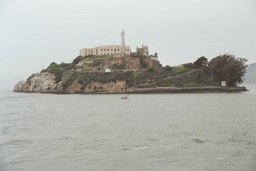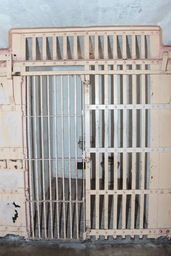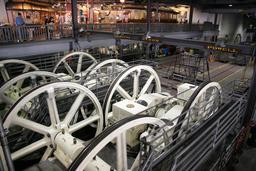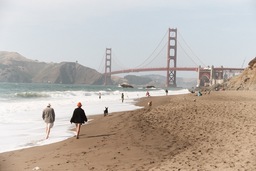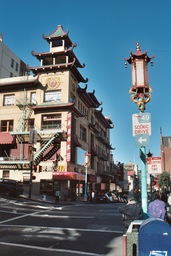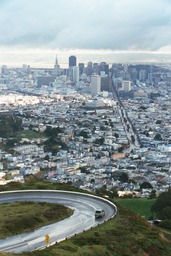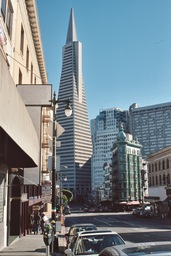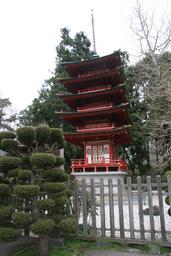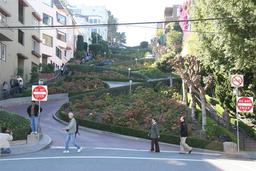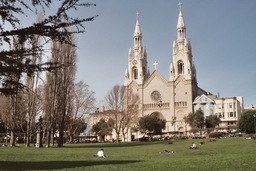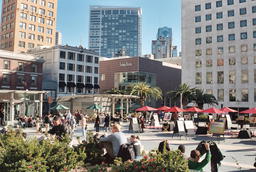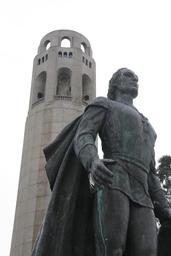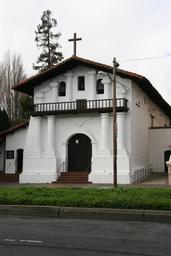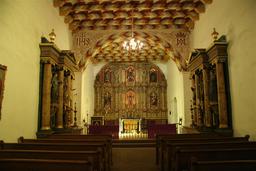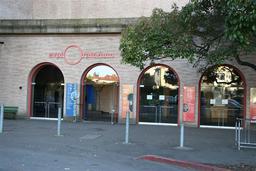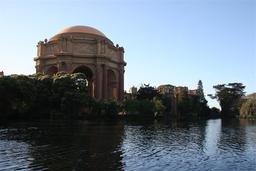|
Click to see larger pictures |
Golden Gate Bridge
Golden Gate Bridge is probably the most recognized San Francisco landmark. Since I moved here many of my friends come to visit and because of this I have the chance to go to Golden Gate Bridge maybe 10 times a year. But I never get tired of walking on the bridge which is about 2 miles long. On a sunny day you are rewarded with great views of Alcatraz, San Francisco and the Pacific Ocean. But foggy days can be interesting too. I usually stop at one of the vista points at the two ends and walk all the way to the center where you can touch the main cable and be impressed by the magnificent engineering that went into building the bridge. If you stop at the vista point before the tolls you can find a section of the main cable. After crossing the bridge make a U-turn at Alexander exit and continue up the hill for beautiful views of the bridge and San Francisco.|
Click to see larger pictures |
Sea lions at Pier 39
Frankly I consider Pier 39 with its carnival-like atmosphere a tourist trap, but I like the sea lions. They started arriving here in 1990; they used to be seasonal and come every January but now they're here all year round. They're smelly and noisy but so fun to watch.|
Click to see larger pictures |
Alcatraz
Everybody heard of Alcatraz as the maximum security prison but it only served this purpose from 1934-63. Before 1934 it served as a fort for the US military until 1907 when it became a military prison. Unoccupied from 1963 to 1969 the islands was taken over by members of the American Indian Movement. Today Alcatraz is part of the Golden Gate National Recreation Area. To get to Alcatraz you need to take a Blue & Gold Fleet ferry which departs from Pier 41. Booking in advance is recommended, especially in summer.|
Click to see larger pictures |
Inside Alcatraz
Most buildings on the island are now in ruins but the cellhouse is intact and can be visited. Rent one of the self-guided audio-tours available at the entrance; they are well made and a good value for the money. While you stroll through the corridors between the blocks you get to hear former inmates talking about the harsh life on Alcatraz and you listen to details about different escapes tried by the prisoners. Some of the cells are open so you can enter and look around. We went there on a cold day (which is every other day in San Francisco) and the wind blowing through the corridors and the freezing temperature gave this place an even more depressing look.|
Click to see larger pictures |
Cable Cars
Cable cars are considered one of the San Francisco signatures. This public transportation system was invented in 1873 and was designed to deal with the city's steep slopes. Presently there's only three lines left (Powell-Mason, Powell-Hyde, and California Street). The concept is quite simple. Under the city streets there's looped cable which is powered from the central powerhouse. When the cable car gripman operated the handle the grip grabs the cable and the cable car is pulled along by the moving cable. So hop in and enjoy the ride.|
Click to see larger pictures |
Cable Cars Barn and Museum
The massive brick building located at the junction of Mason and Washington Streets is San Francisco's only surviving cable car barn. Although the building's main function is as a powerhouse and barn, it also houses a small museum which offers insight into the inner workings of the cable car system as well as historical tidbits regarding cable cars. On the upper level there is a balcony which offers a view of the huge wheels over which the continuous loops of cables are revolving. It's quite an impressive sight, especially when you realize that the entire cable car system is run from here (the signs above the huge wheels read "California" "Mason" "Hyde" "Powel", the only remaining cable car lines). The museum's exhibits include the Car No 8, the only survivor of San Francisco's first cable car line, which began operation in 1873. The museum also includes explanatory displays, historical tools and photos. Downstairs you can take another look at the "sheave" (wheel) room where the thick steel cables enter the building before being routed up to the main sheaves. Address: 1201 Mason St. at Washington.|
Click to see larger pictures |
Baker Beach
Baker beach is to me the best of SF's beaches. It not a good place to swim because of the strong currents but if you tried to swim in the Pacific Ocean around San Francisco you'll know the water is too cold for swimming anyway. But you can sunbathe and fish and walk along the beach looking at the Golden Gate Bridge. At the end of the beach there are tables and grills for barbequing.|
Click to see larger pictures |
SF Museum of Modern Art
This is the place to see modern art in San Francisco. SF MOMA's collection includes major works by the 20th-century artists from post-impressionists to latest contemporary art. The beautiful building designed by the Swiss architect Mario Botta has a central skylight which gives the atrium a theatrical feel. The museum was created in 1935 but moved to its current location in the South of Market neighborhood in 1995. Works by the 20th-century European artists are located on the second floor including paintings by Matisse, Braque, Picasso and a beautiful sculpture by Brancusi. There are three paintings that I really enjoyed and I believe should not be missed: "The flower carrier" by Diego Rivera, "Frieda and Diego Rivera" by Frida Kahlo and "Guardians of the secret" by Jackson Pollock. The two upper floors are dedicated to temporary exhibitions. Address: 151 Third Street (between Mission and Howard Streets).|
Click to see larger pictures |
Chinatown (I) : The Gate
The Chinatown gate can be found at the intersection of Bush St. and Grant Avenue. It has three beautifully ornated arches and is guarded by two lions. Its design was inspired after ceremonial entrances of Chinese villages. The materials were provided by the Taiwan government and the design belongs to Clayton Lee. The gate opened in 1970. Once you pass through it, you'll find yourself surrounded by a multitude of shops selling souvenirs, jewelry, electronics, artwork etc. Address: Bordered by Broadway, Bush, Kearny, Stockton St.|
Click to see larger pictures |
Chinatown (II): Grant Avenue
Grant Avenue, between Bush Street and Broadway is the main tourist street of Chinatown. The avenue is lined with dragon-entwined lamp posts and buildings that borrow elements from Chinese architecture, with towers and curved rooftops. Grant Avenue is an odd mix of souvenir shops for tourists, restaurants, banks etc. The parallel Stockton Street seems to cater more for the local Chinese community.|
Click to see larger pictures |
Twin Peaks
This point offers a great panorama of downtown, the bay and the two bridges and the views are beautiful both at the daytime and at night. There is a parking lot at the top but you can also get there by bus (No. 37) followed by a little hiking. Climb one of the two hills and you'll get a 360 degrees view of the city. It's better if you bring a light jacket, otherwise the wind will make you leave too soon.|
Click to see larger pictures |
Fisherman's Wharf
I believe that Fisherman's Wharf is San Francisco's number one tourist trap but in a way getting there is unavoidable for the San Francisco's tourist. The sea lions at Pier 39 are located here; the Alcatraz ferrys or the bay cruises have Fisherman's Wharf as a starting point. But the place is a tourist trap. Think about it: Fisherman's Wharf has a Ripley Believe It or Not! Museum, a Wax Museum and a Rainforest Cafe. Plus a great number of souvenir stores where you can buy anything from bumper stickers to t-shirts reading "I left my heart in San Francisco" or "I escaped from Alcatraz".Fisherman's Wharf has lots of seafood restaurants and sidewalk stands where sea products are sold. Try to sample some of the food; it's not exactly fine dining but it's good. Some restaurants offer nice views of the bay along with food. Be warned that this place is very crowded; Fisherman's Wharf has its share of street performers with their mine and music acts; one of the funniest acts is the "Bushman" (you'll recognize him right away).
|
Click to see larger pictures |
Transamerica Pyramid
The Transamerica Pyramid is the most remarkable presence in San Francisco's skyline. Located in the financial district, it's the tallest building in the city, measuring 853 ft (256m) from the street level. It was designed by William Pereira as an office building for Transamerica corporation, a financial institution. The building opened in 1972. The public is not allowed at the upper floors. Address: 600 Montgomery St|
Click to see larger pictures |
Japanese Tea Garden
Located in the Golden Gate Park, the Japanese Tea Garden is one of the most popular attractions in San Francisco. It was established in 1894 and for many years it was tended by the Japanese gardener Makota Hagiwara. The garden is made of a maze of winding paths lined with Japanese trees, shrubs and flowers, a few ponds and a wooden pagoda. The Moon Bridge takes its name from its form and close to the tea tables one can find a large statue of Buddha that was cast in Japan in 1790. The open teahouse offers tea and cookies and is a perfect place for relaxation.|
Click to see larger pictures |
Muir Woods
At the base of Mount Tamalpais is the Muir Woods National Monument, a forest of old coast redwoods, one of the few remaining in California. The woods are named after John Muir, a naturalist and conservationist who fought for the creation of national parks. The Main Trail is paved and is very crowded especially on weekends; it features one of the tallest trees in the forest. If you follow one of the trails branching from the Main Trail you can leave the crowds behind and enjoy a nice hike. Muir Woods is accesible by car. There is no public transportation but you can find some tour companies that go there.|
Click to see larger pictures |
Alamo Square
You've probably iseen an image of the Alamo Square Victorian houses long before coming here. When a director of a movie or sitcom wants to give the audience some hints that the action takes place in San Francisco, they show a few opening shots which are almost always the same: the Golden Gate Bridge, a cable car, the Coit Tower, a steep street and the Victorian houses at Alamo Square. This image is one of the San Francisco signatures, appearing on postcards and on the covers of many guidebooks. It's also one of the most photographed views of the city. I guess what makes this viewpoint special, besides the six beautiful houses, is the background of the city downtown with its skyscrapers. The six Queen Anne-style houses were completed in 1895. They are very similar, I believe their beauty also resides in the little differences (it would have been less interesting to have 6 identical houses or 6 totally different houses). Address: At the intersection of Steiner and Hayes streets.|
Click to see larger pictures |
Lombard Street
Lombard Street is another postcard perfect San Francisco attraction. Because of that it's also very popular and no matter the day of the year you'll find numerous people taking pictures here. The attraction is advertised as the "crookedest street in the world" with eight curves in one block descent from Hyde to Leavenworth. The street wasn't always crooked (evidently) but its natural grade of 27 degrees made it harder for the earlier automobiles to climb it. Around 1920, the switchbacks were added and in the process the curve incline was reduced to 16. Cars can only go downhill while on the two sides there are stairways for pedestrians. The views from the top of the section are beautiful (towards the Coit Tower and the Alcatraz). It's nicer to visit in the summer when the flowers are in bloom. Address: Lombard Street. Descent begins at Hyde Street.|
Click to see larger pictures |
North Beach
North Beach is known today as the Italian neighbourhood although many immigrant settlers of different ethnic background called this place home before the Italians. North Beach is one of the touristy parts of San Francisco that I visit often, the reason being the joyfull atmosphere and the fact that you can dine outside in numerous places. It's a nice place to stroll and a good place to eat. At one point in time North Beach used to be the bohemian neighbourhood of San Francisco, home for the San Francisco's Beat counterculture so a walking tour of the neighbourhood must include the Vesuvio Caffe, the City Lights Bookstore, the Tosca and Trieste Caffes, all places of gatherings for the "beatniks" like Jack Kerouac and Allen Ginsberg. Another highlight of this area is the Washington Square Park lined on one side by the Saints Peter and Paul Church, a beautiful Gothic Revival church. And finally, no tour of San Francisco will be complete without seeing the Coit Tower, which sits on top of Telegraph Hill. At night this place becomes even more vibrant, with numerous bars, saloons and lots of jazz clubs. Really nice. And I almost forgot about Broadway Street, also part of North Beach. It's the "adult entertainment" zone.|
Click to see larger pictures |
Union Square
Union Square is the heart of the city's shopping district. Many of San Francisco's largest department stores can be found here, names like Macy's, Saks Fifth Avenue, Neiman Marcus and Levis. On the west side lies the famous Westin St. Francis hotel. The square is named after the big pro-Union rallies that were held here during the Civil War of 1861-1865. In the center of the square there is a statue of Victory, on top of a tall column. It's called the Dewey Monument, which commemorates Admiral Dewey's victory at Manilla during the Spanish-American war of 1898. The square has been redesigned recently; now it's almost only concrete and stone, with a few green touches. There is one caffe in the square where you can buy a coffe and sip it in the sun while enjoying the display of architecture around you and the people going by. On weekends local artists display their paintings here.|
Click to see larger pictures |
Coit Tower
Coit Tower represents another San Francisco signature landmark, one that appears in all the movies when we're supposed to understand that the action will take place in San Francisco. It sits at the top of Telegraph Hill, in a great location with gorgeous views all around. It's a popular tourist attraction and if you come here by car and on a weekend you'll wait ages to get to the parking lot at the top. I prefer to hike up Telegraph Hill and do some little exercise along the way - well, weather permitting :) There's also a MUNI bus that goes to Coit Tower, the #39. The tower was built in 1933 with funds left by Lillie Hitchcock Coit, an eccentric San Franciscan. Inside, the lobby is decorated with murals (since I like their story I'll write a separate tip about them). A short elevator ascent will take you to the observation deck where you'll find the gorgeous views I was talking about. There's Bay Bridge to the east, downtown San Francisco with Transamerica to the south, Marin County to the north and Russian Hill and the Golden Gate Bridge to the west. The tickets for the observation deck are sold in the gift shop (to tell you the truth, I think $3.50 is too expensive, but hey, you're on vacation). I almost forgot; the architect was Arthur Brown, who's done quite a bit of work in the San Francisco area including the San Francisco City Hall.|
Click to see larger pictures |
The story of the Coit Tower murals
The murals in the lobby of Coit Tower have an interesting story of their own. They were commisioned in 1934 by the Public Works of Art Project (PWAP), a government funded program designed to keep artists employed during the Great Depression. The murals depict life in modern California and they were painted by 25 local artists, students of the famouse Mexican communist artist, Diego Rivera. Scenes range from the busy streets of the Financial District (with a robbery in progress) to factories and the Central Valley wheat fields. Seeing the murals you can sense the social commentary. The work criticizes the economic inequities of life during the Great Depression, and that made the murals highly controversial when the project was finished. Many where upset with the work's political content, seeing the murals as Communist inspired. Responding to pressure the San Francisco Art Commision delayed the opening of the Coit Tower and considered destroying the murals. After numerous debates Coit Tower was finally opened to the public in October 1934. What amazed me is that the murals are remarkable close in style despite the fact that so many different artists created them.|
Click to see larger pictures |
Mission Dolores (I)
Mission Dolores is San Francisco's oldest building, dating from 1791. Its formal name is Mission San Francisco de Asis but it became known as Mission Dolores from a nearby pond (long gone), La laguna de los Dolores (Lake of Our Lady of Sorrows). The small chapel was preserved almost intact, its 4 ft (1.2m) thick walls having survived two major earthquakes. When the Mexican government secularized the missions in 1834 to acquire their lands, Mission Dolores was transformed into a tavern and dance hall until finally in 1859 was reacquired by the Catholic Church and reconsecrated. Along the years the Catholic Church erected a series of larger churches alongside the old chapel to accommodate a growing congregation. The last of these, the basilica that can be seen next door was added in 1913. The facade of the basilica is highly ornated, which brings out even more the simple beauty of the mission chapel.|
Click to see larger pictures |
Touring the Mission Dolores (II)
I really enjoyed my tour of Mission Dolores. I visited on a Wednesday morning when only a few people were around, and most of the time I found myself alone during the tour. The tour starts with the small chapel, beautifully washed in yellow light. The wooden altar was hand carved in Mexico and brought to the mission in 1780. The beamed ceiling is covered in multicolored motifs which are said to resemble the local Ohlone Indian decorative patterns. On the floor of the chapel there are a few plaques marking the burial sights of prominent locals. As you exit the chapel there is a diorama of the mission as it appeared in 1799. From there you can go into the new basilica which has some beautiful panels and stained glass windows. Next you'll find the small museum which houses different religious artifactsy or things found during the restorations of the chapel. Inside the museum, on the left as you enter, a section of the wall plaster is cut away to show the thick adobe bricks. The last stop of the tour is the cemetery, where many local notables from the early times of the city are buried. If you read the names on the graves you'll recognize the names of many streets in San Francisco. The cemetery also holds the remains of more than 5000 Native Americans most of whom died in the measles epidemics of 1804 and 1826. The cemetery was green and peaceful and I saw a few hummingbirds. The entrance fee is $3 and $2 more if you want the audio tour.|
Click to see larger pictures |
The Exploratorium
The Exploratorium is the most engaging science museum that I've seen so far. Their philosophy is to teach science through hands-on participation and that's what makes it interesting. You'll have to push buttons, rotate wheels or perform a wide variety of other actions to set the experiments in motion. Each experiment has instructions and explanations nearby so you can understand what it is you're setting in motion. We spent 3 hours there and only got through half of the museum before the closing hours (well, we are geeks so maybe we were enjoying it more than other people). It is incredibly fun. Exhibits are located on the main floor and mezzanine level being divided into 13 subjects areas Electricity, Motion, Weather, Vision, Light, Color and Sound. The Exploratorium was established in 1969 by physicist Frank Oppenheimer who was the one that embraced the philosophy that it's best teach science through hands-on participation. The museum was full of kids, so if you travel with kids this is one of the places in San Francisco that would be nice to visit. The top attraction of the museum is the Tactile Dome, a totally dark sphere in which you crawl your way along, touching sensorially stimulating objects and textures (not for claustrophobes). You'll need reservations for the Tactile Dome.|
Click to see larger pictures |
Palace of Fine Arts
The Palace of Fine Arts is San Francisco's most dramatic piece of architecture. Despite the name is not an art museum or a palace for that matter but rather a Classical style ruin at the edge of a beautiful lagoon. It was designed by the Bay Area architect Bernard Maybeck for the Panama-Pacific International Exposition in 1915 and built with the intention to last until the end of the exhibition. When the buildings of the fair were torn down, citizens lobbied to spare the Palace of Fine Arts. And spared it was but by early 1960s the building which was made from such materials as wood, plaster and burlap started to crumble and became a ruin in the true sense of the word. Finally, the money for reconstruction was found and in 1962 the building was rebuilt using reinforced concrete. The lagoon is the perfect spot for an afternoon walk, watching the swans gliding on the lake in front of the rotunda.|
Click to see larger pictures |
Castro
The Castro district is the center of the San Francisco's gay community. I live nearby and often come here to eat, there are many good restaurants in this area. The neighborhood centers around the intersections of Castro and 18th streets. It's a lovely neighborhood, alive at all times of day. Castro started emerging as a gay district in the early 1970, when gay San Franciscans began buying properties in this area and gay bars started opening here. The side streets are also worth exploring, lined as they are with rows of beautiful Victorian houses. You'll notice many of the windows displaying the rainbow flag. One of the area's highlights is the Castro Theater, a beautiful building where you can catch some interesting films (let's just say that you won't find the latest Hollywood blockbuster here). On Halloween the streets are closed to car traffic and a big costumes party takes place here.|
Click to see larger pictures |
Japan Center
The Japan Center is a large shopping and dining complex centered around a five-tiered concrete pagoda called the Peace Pagoda. The complex dates from the 60's when blocks of Victorian houses in this area were demolished, Geary Boulevard was widened and the five building structure of Japan Center was built. Inside the complex there are numerous Japanese restaurants, art galleries and antiques shops, music and video stores as well as a big Japanese bookstore (they sell titles in English as well). The AMC Kabuki Theater is one of the places that hosts the San Francisco International Film Festival (every year in April).|
Click to see larger pictures |


